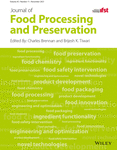Red raspberry (Rubus ideaus L.) extracts: A novel ingredient in cemen paste
Abstract
Red raspberry (Rubus ideaus L.) has promising potential for the concept of “clean-label food” as a natural coloring and flavoring agent as well as its bioactive properties. The objective of this study was to determine some properties of lyophilized red raspberry water extract (LRWE) and its optimal levels contributing to the improvement of pastırma cemen paste (CP) quality. LRWE displayed high total phenolic and anthocyanin content, and strong antioxidant activity. Incorporating LRWE into CP improved the instrumental redness and sensory color scores between 10.52%–38.79% and 9.62%–71.55%, respectively, depending on the extract level. Compared to the control, the pH, lightness (L*), and yellowness (b*) values of CP decreased with the addition of LRWE, while the redness (a*), titratable acidity, anthocyanin content, and metal chelating activity (MCA) increased. According to these results, 3%, 4%, and 5% LRWE levels can be recommended to enhance the color, sensory acceptability, and functional properties of CP.
Novelty impact statement
Although the formation and maintenance of the desired color in pastırma cemen paste is an important problem, studies to overcome this problem are quite limited. Natural plant extracts have been widely used in the food industry in recent years as colorant, antioxidant, and antimicrobial due to consumer health concerns. The results of this study showed that the anthocyanin-rich LRWE can be utilized as a natural alternative to synthetic and insect-based colorants in CP production. In this way, better quality and reliable pastırma production will be possible using clean-label natural colorants instead of synthetic dyes.
CONFLICT OF INTEREST
The authors have declared no conflicts of interest for this article.
Open Research
DATA AVAILABILITY STATEMENT
The data that support the findings of this study are available from the corresponding author upon reasonable request.




